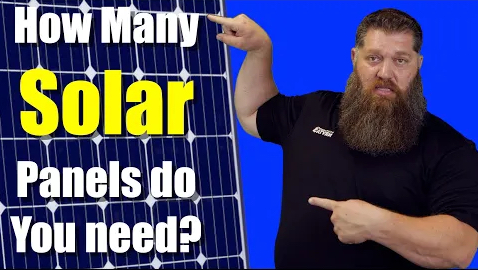There seems to be a theory floating around on how many solar panels are needed for your RV, which is you need 1 watt for every amp hour of battery you have. For instance, if you have a 200 amp hour battery, a 200 watt solar panel will be enough- and I can tell you that is simply not true. For those of you just getting into solar, I’ll recommend that you use lithium batteries, as they’re a far better choice when it comes to using high amp demands through an inverter. Now let’s get into some of the theory behind how many solar panels, or how much wattage we have, going to our batteries.
When we’re using the older style batteries, such as lead acid, gel or AGM, there’s a limit on how much current can charge those batteries. Typically we are looking anywhere between 35-55 amps on a continuous basis. What we don’t want to do is overtax the batteries. As a result, there’s a theory that for every watt you can have one amp hour and for every amp hour battery you can have a single watt. Well, here’s the thing: watts are determined by volts times amps, so it’s actually a 12/1 ratio.
Honestly, you don’t need to know that. What you DO need to know is that if you switch over to solar and choose lithium batteries, you want to see how much power you’re actually consuming. So when we’re looking at how many solar panels we need, what we ultimately need to know is how much power we are consuming during the day. If we can supply that much power on the roof, then we aren’t using our batteries during the day and we’re saving for night time. On an average RV we can typically get anywhere from 2000-3000 watts, so wouldn’t it be great if you could get 3000 watts on your roof if you’re only consuming about 3000 watts inside your rig? Now you’re saving your batteries for the night time when you have no sun, and that’s the goal.
So the great thing about solar panels is that you can add to them, so you can start off with one or two and as long as you’re not exceeding the output of your solar controller (we covered last week that you can use a solar controller which will feed not only the batteries, but it’s also connected in line with your inverter) you can continue to add more. Now if you do add more, you may have to add more solar controllers, but it is something you can add more of as you go on.
If you want to learn more about solar controllers click here:What are MPPT Solar Charge Controllers?
So you bought 800 watts of solar and you’re not getting 800 watts all the time. Well, 800 watts is the peak of what you’re going to receive, so when are you going to get that? When the sun is directly over your solar panels and you’re getting a perfect sun strike, so typically around noon. When we see that these panels are rated for 200 or 300 watts each, there are conditions. One, as I stated previously, is that the sun strike has to be in the prime position without obstructions, and number two: if it’s extremely hot outside, in the 100 degree range, it will kill our amperage as well as voltage, so that’s going to slow down how many watts we can go through. However, on very cold days with the sun straight above in the optimal position you’ll be at maximum voltage.
And there’s your Tech Tip!
If you would like to be able to fix the majority of the problems on your RV, or let’s say you want to open a business and become a certified technician or inspector? Head over to our website at www.nrvta.com, select the programs tab and get started today!

